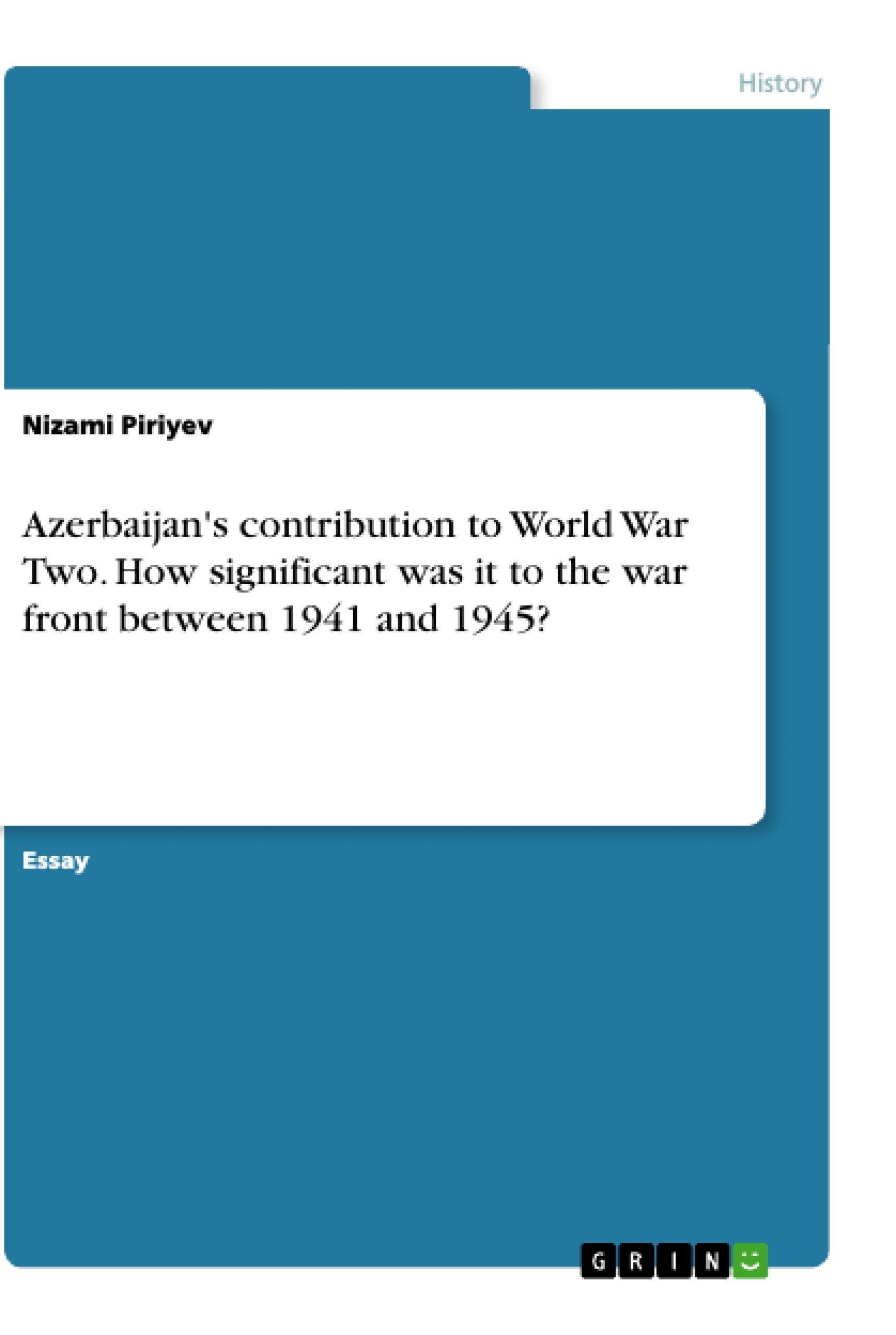This essay is about the question, "How significant was Azerbaijan’s contribution to the war front between 1941 and 1945?"
To answer this specific enquiry, the topic of oil extraction in Baku will be discussed in detail, because of Azerbaijan’s incredibly high contribution of oil. The Republic’s military capacity and efficiency, as well as its human capital capabilities, with a focus on medical and technological abilities of the population, will be assessed too.
To achieve these objectives, a variety of Soviet and non-Soviet sources will be employed. A specific time frame between 1941 and 1945 will be scrutinized, for this is the period when Nazi Germany and USSR combated. The purpose of this dissertation is to illustrate, using evidence and critical thought, that Azerbaijan did make a significant contribution towards the war front.
Inhaltsverzeichnis (Table of Contents)
- Oil Extraction in Baku
- Azerbaijan's Military Capacity and Efficiency
- Human Capital Capabilities
- Oil in World War Two
- The Battle of Kursk
- Strategic Importance of Baku
- Soviet Endurance and Germany's Limitations
- Azerbaijan's Oil Production
- Azerbaijan's Global Contribution
- Criticisms of Azerbaijan's Oil Contribution
- Significance of the "Second Baku"
- Costs of Oil Extraction
- Exclusive Qualities of Azerbaijani Oil
Zielsetzung und Themenschwerpunkte (Objectives and Key Themes)
This dissertation explores the vital contribution of Azerbaijan to the war front between 1941 and 1945. It examines the significance of oil extraction in Baku, the republic's military capacity and efficiency, and its human capital capabilities, with a focus on medical and technological abilities. The dissertation aims to demonstrate through evidence and critical thought that Azerbaijan played a crucial role in the war effort.
- The importance of Baku's oil extraction and its role in fueling the Soviet war machine
- Azerbaijan's military capabilities and contributions to the war effort
- The impact of Azerbaijan's human capital on the war, particularly in medical and technological fields
- The strategic significance of Baku oil in relation to the outcome of the war
- The relative contributions of Azerbaijan and the "second Baku" oil fields in the Soviet war effort
Zusammenfassung der Kapitel (Chapter Summaries)
- Oil Extraction in Baku: This chapter details the significance of Baku's oil production to the Soviet war effort, highlighting its historical significance and its contribution to the global oil industry.
- Azerbaijan's Military Capacity and Efficiency: This section explores the role of Azerbaijani soldiers and military units in the war effort, focusing on their participation in key battles and their contribution to Soviet successes.
- Human Capital Capabilities: This chapter examines the contributions of Azerbaijani citizens to the war effort beyond military service, including their role in medical care and technological advancements.
- Oil in World War Two: This chapter explores the general importance of oil in World War Two, its various uses, and the increasing demand for it as the war progressed.
- The Battle of Kursk: This section focuses on the Battle of Kursk as a prime example of the pivotal role of oil in mechanized warfare and the dependence of the Soviet military on Azerbaijan's oil reserves.
- Strategic Importance of Baku: This chapter demonstrates the strategic importance of Baku's oil fields through the perspective of both Soviet and Nazi leadership, emphasizing the importance of Baku's capture for both sides.
- Soviet Endurance and Germany's Limitations: This section compares the strategic advantages and limitations of the Soviet and Nazi armies in the context of oil resources, highlighting Azerbaijan's crucial role in Soviet success.
- Azerbaijan's Oil Production: This chapter explores the scale and significance of Azerbaijan's oil production during the war, highlighting its contribution to the Soviet war effort and its relative position in the global oil industry.
- Azerbaijan's Global Contribution: This section discusses the debate surrounding the exact proportion of Azerbaijan's oil production that contributed to the global oil market, highlighting the significance of Baku's oil fields.
- Criticisms of Azerbaijan's Oil Contribution: This chapter examines criticisms of Azerbaijan's contribution to the war effort, focusing on arguments that downplay its importance and highlight the role of the "second Baku" oil fields.
- Significance of the "Second Baku": This section explores the discovery and impact of the "second Baku" oil fields, focusing on their ability to supplement Baku's production and their limitations in the context of the war effort.
- Costs of Oil Extraction: This chapter examines the costs associated with the intensive extraction of oil at the Baku oil fields during the war, highlighting the potential long-term consequences of Soviet policies.
- Exclusive Qualities of Azerbaijani Oil: This section explores the unique qualities of Azerbaijani oil, highlighting its suitability for the Soviet war effort and its advantages over other oil sources available to the Soviet Union.
Schlüsselwörter (Keywords)
Key terms and concepts related to this work include Azerbaijan, Baku, oil extraction, World War Two, Soviet Union, Nazi Germany, military capacity, human capital, strategic importance, oil reserves, global oil industry, "second Baku", oil production, and the costs of oil extraction.
- Quote paper
- Nizami Piriyev (Author), 2020, Azerbaijan's contribution to World War Two. How significant was it to the war front between 1941 and 1945?, Munich, GRIN Verlag, https://www.grin.com/document/1000685



